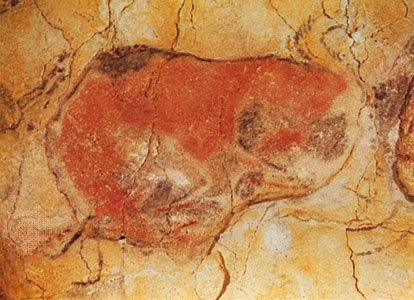Magdalenian culture
prehistoric technology and art
 toolmaking industry and artistic tradition of Upper Paleolithic Europe, which followed the Solutrean industry and was succeeded by the simplified Azilian; it represents the culmination of Upper Paleolithic cultural development in Europe. The Magdalenians lived some 11,000 to 17,000 years ago, at a time when reindeer, wild horses, and bison formed large herds; the people appear to have lived a semisettled life surrounded by abundant food. They killed animals with spears, snares, and traps and lived in caves, rock shelters, or substantial dwellings in winter and in tents in summer. The great increase in art and decorative forms indicates the Magdalenians had leisure time. They also experienced a population explosion, living in riverside villages of 400 to 600 persons; it has been estimated that the population of France increased from about 15,000 persons in Solutrean times to over 50,000 in Magdalenian times.
toolmaking industry and artistic tradition of Upper Paleolithic Europe, which followed the Solutrean industry and was succeeded by the simplified Azilian; it represents the culmination of Upper Paleolithic cultural development in Europe. The Magdalenians lived some 11,000 to 17,000 years ago, at a time when reindeer, wild horses, and bison formed large herds; the people appear to have lived a semisettled life surrounded by abundant food. They killed animals with spears, snares, and traps and lived in caves, rock shelters, or substantial dwellings in winter and in tents in summer. The great increase in art and decorative forms indicates the Magdalenians had leisure time. They also experienced a population explosion, living in riverside villages of 400 to 600 persons; it has been estimated that the population of France increased from about 15,000 persons in Solutrean times to over 50,000 in Magdalenian times.Magdalenian stone tools (tool) include small geometrically shaped implements (e.g., triangles, semilunar blades) probably set into bone or antler handles for use, burins (a sort of chisel), scrapers, borers, backed bladelets, and shouldered and leaf-shaped projectile points. Bone was used extensively to make wedges, adzes, hammers, spearheads with link shafts, barbed points and harpoons, eyed needles, jewelry, and hooked rods probably used as spear throwers. Bone tools were often engraved with animal images.
The widespread resumption of artistic production in the early Magdalenian Period was marked at first by a return to simple line drawing and a retreat from the Aurignacian achievements in modeling and polychromy. Generally, coarse black drawings with little concern for detail or finish characterized monumental cave art in this early phase. It may be distinguished as part of a later school by its continuation of Solutrean plastic tendencies and its correct draftsmanship in the treatment of feet and horns and of perspective in general. Later, however, as the new school consolidated itself, there was an increasing and striking naturalism in all the arts. The small arts, already at a high level in the Aurignacian era, reached a climax in the Magdalenian Period, with delicate, detailed engravings and carvings in the round; in engravings two or more animals were often represented together in a recognizable scene. The outstanding achievement of Magdalenian art, however, was the cave engraving and polychrome painting of its late phase. There was little interest in formal composition or relationships between figures, but the figures themselves, especially in painting, were remarkably beautiful, with lively realism, excellent rendering of volumes, subtle expressive poses, and sophisticated design. Some of the finest examples of this late painting are at Altamira (q.v.), a cave in northern Spain.
Magdalenian culture disappeared as the cool, near-glacial climate warmed at the end of the Fourth (Würm) Glacial Period (c. 10,000 BC), and herd animals became scarce. It has been suggested that the complexity of the later cave art represents an attempt by Magdalenian man using “sympathetic magic” to cause the animals to once more become abundant. The Azilian (Azilian industry) culture, which followed the Magdalenian, was much simplified, and there is a poverty of art; clearly the richness of Magdalenian culture owes much to the abundance of food, allowing time for leisure and the development of religion and aesthetics.
- Aczél, György
- Acámbaro
- AD 1900-2000 1 Religious Adherents in the United States of America
- AD 1900-2000 2 Religious Adherents in the United States of America
- AD 1900-2000 3 Religious Adherents in the United States of America
- AD 1900-2000 4 Religious Adherents in the United States of America
- AD 1900-2000 Religious Adherents in the United States of America
- AD 1900-2000 Religious Adherentsnin the United States of America
- Ada
- Adab
- adab
- Ada Clare
- Adad
- adage
- Ada group
- Adah Isaacs Menken
- Adair, John
- Adair v. the United States
- Ada King, countess of Lovelace
- Ada King Lovelace, countess of
- Adal
- Adalbero Of Ardennes
- Adalbert
- Adalbert Falk
- Adalbert Kuhn